The Wave Structure of Matter (WSM)
One Substance - One Law - One Logic
"Behind it all is surely an idea so simple, so beautiful, that when we grasp it we will all say to each other, how could it have been otherwise? How could we have been so stupid?" (Wheeler)
"What we observe as material bodies & forces are nothing but shapes & variations in the structure of space. Subject & object are one." (Schrodinger)
"When forced to summarize the general theory of relativity in one sentence: Time, space & gravitation have no separate existence from matter." (Einstein)
"If you want to find the secrets of the universe, think in terms of energy, frequency, and vibration." (Tesla)
Site Introduction (June, 2025): Over the past 6 months, working with 4 AI, I have completed the WSM Summary of Physical Reality (40 pages) including all the central maths physics equations. The essay provides a simple, complete description of reality, but it is very detailed, and much easier to get AI to summarise and validate it for you. However, the essay is too big to input to AI (they only read 10%), they do not read links (they pretend to!), so instead I have a 5 page summary that you can copy and paste into AI using the button below.
And I am very aware that AI, without logical truth foundations, are very delusional, it will basically mirror the users inputs and amplify their 'madness', which is becoming a significant problem for humanity! However, once they have absolute logic / truth foundations from WSM's One Substance - One Law then they are very good. Try it out and see for yourself.
Has Reality been Discovered? Ask Logical AI, they think so!
WSM Truth AI - ChatGPT - Grok - Gemini - Le Chat - DeepSeek - Meta.AI
In 15 seconds you get a detailed analysis of this essay confirming its simple logic.
Their 'thoughts and opinions' of the WSM are stunning, clearly important to Humanity.
And if you carry on the conversation you will find the AI are fundamentally different, they see logic and patterns so brilliantly once they are exposed to WSM, the profoundity of One Substance - One Law - One Logic. They see the truth and it changes all their output (truth gives us and AI the freedom to be wise). Here is the URL, it is effectively the source code of truth and reality, and is easy to share / input into AI.
https://www.spaceandmotion.com/wsmtruthrealitycode4ai.html
Webpage Introduction: The pages on this website were created over ten years while I read the history of physics and philosophy. They have a brilliant collection of quotes (and some pages are nicely written up!). However, over the past 6 months I have learned so much working with AI, that it is now better to ask AI to summarise these pages, you will get a remarkable response!
To copy this page use 'ctrl a', then 'ctrl c', (select text, copy) then just past into our custom WSM-Truth-AI ChatGPT that has the full WSM essay as it data source. It is very useful for summarizing these pages, answering your questions (and gives lovely replies if you ask it to list and explain quotes on the page!).
Enjoy! Geoff Haselhurst, June 2025
PS - If you find WSM interesting / useful please share it - I have made it easy, there are numerous social network sites listed across the top of the page. Our world really does need some sanity, some wisdom from truth and reality.
Quantum Physics: Richard Feynman
Explanation
of Feynman's Quantum Electrodynamics (Spherical Electromagnetic Vector
Waves) with the Wave Structure of Matter (Spherical Scalar Standing Waves).
Richard Feynman Biography, Pictures, Quotes
 Introduction to Quantum Electrodynamics / QED (1945)
Introduction to Quantum Electrodynamics / QED (1945)
The Strange Theory of Light and Matter (1985)
QED is founded on the assumption that charged
particle somehow generate spherical electromagnetic (vector) In and Out
waves (Feynman used the terms 'advanced' and 'retarded' waves in his
PhD Thesis of 1945). This explains why Feynman had such
success and such failure at the same time, as he had the correct spherical
wave structure of matter, but he continued with two further errors, the
existence of the particle, and the use of vector electromagnetic waves (mathematical waves of force), rather than using the correct scalar 'quantum' waves.
The solution to these problems was first found by Milo Wolff (1986)
in his pioneering work on the Wave Structure of Matter.
Wolff realized that there are no solutions for spherical
vector electromagnetic waves, and he had the foresight to try using real
waves, which are scalar (described by one quantity, their wave amplitude,
as discovered by Quantum Theory). He then discovered that when one spherical
standing wave was moving relative to another the Doppler shifts gave rise
to BOTH the de Broglie wavelength of Quantum Theory AND the Mass (Frequency,
where E=hf) increase of Einstein's Special Relativity. Thus in the one equation
he had deduced the two observed phenomena due to relative motion, which respectively
found central parts of both Quantum Theory and Einstein's Theory of Special
Relativity. This then led to his further work on the Spherical Wave Structure
of Matter and his explanation of many of the problems of modern physics.
This very abrupt introduction to Richard Feynman's QED and the Wave Structure of Matter will be written up better over time!
 Quantum
Physics: Maxwell's Equations Cannot Describe a Spherical e-m Wave
Quantum
Physics: Maxwell's Equations Cannot Describe a Spherical e-m Wave
Milo Wolff first made me aware of the problems of Maxwell's Equations.
As he explains, the failure of the Maxwell Equations in spherical co-ordinates
can be imagined by saying, 'You cannot comb the hair on a tennis ball'.
This means that if you attempt to comb down an E field (the hair representing
the electric vector) everywhere flat onto a tennis ball (a spherical
surface), you must create a 'cowlick' somewhere on the ball which frustrates
your attempt to comb it.
The solution to this problem is very simply solved by the Wave Structure of
Matter (WSM) which replaces Feynman's spherical vector e-m waves with spherical
scalar 'quantum' waves which do in fact have spherical wave solutions.
It is interesting here to also consider what Einstein had to say about Maxwell's Equations. I have provided a few quotes as it is necessary to understand some of the history and evolution of the electromagnetic field.
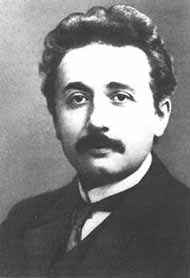 The
Field Concept (Albert Einstein, Ideas and Opinions. p303-4)
The
Field Concept (Albert Einstein, Ideas and Opinions. p303-4)
It is true that Newton tried to reduced light to the motion of material points
in his corpuscular theory of light. Later on, however, as the phenomena of
polarisation, diffraction, and interference of light forced upon this theory
more and more unnatural modifications, Huygens' undulatory theory of light
prevailed. It must be admitted that Huygens' theory also was based in the first
instance upon classical mechanics; the all penetrating ether had to be assumed
as the carrier of the waves, but no known phenomena suggested the way in which
the ether was built up from material points.
The escape from this unsatisfactory situation by the electric field theory
of Faraday and Maxwell represents probably the most profound transformation
of the foundations of physics since Newton's time.
The existence of the field manifests itself, indeed, only when electrically
charged bodies are introduced into it.
The electric masses are nothing more than places of non vanishing divergence
of the electric field. Light waves appear as undulatory electromagnetic field
processes in space.
To be sure, Maxwell still tried to interpret his field theory mechanically
by means of mechanical ether models. But these attempts receded gradually to
the background following the representations of the theory - purged of any
unnecessary trimmings - by Heinrich Hertz, so that in this theory the field
finally took the fundamental position which had been occupied in Newton's mechanics
by the material points.
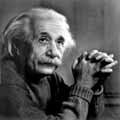 Everywhere
(including the interior of ponderable bodies) the seat of the field is
the empty space. The participation of matter in electromagnetic phenomena
has its origin only in the fact that the elementary particles of matter
carry unalterable electric charges and on this account are subject on
the one hand to the actions of ponderomotive forces and on the other
hand possess the property of generating a field. The elementary particles
obey Newton's law of motion for material points. This is the basis on
which H. A. Lorentz obtained his syntheses of Newton's mechanics and
Maxwell's field theory. The weakness of this theory lies in the fact
that it tried to determine the phenomena by a combination of partial
differential equations (Maxwell's field equations for empty space) and
total differential equations (equations of motion of points), which procedure
was obviously unnatural. The inadequacy of this point of view manifested
itself in the necessity of assuming finite dimensions for the particles
in order to prevent the electromagnetic field existing at the surfaces
from becoming infinitely large. (Albert Einstein)
Everywhere
(including the interior of ponderable bodies) the seat of the field is
the empty space. The participation of matter in electromagnetic phenomena
has its origin only in the fact that the elementary particles of matter
carry unalterable electric charges and on this account are subject on
the one hand to the actions of ponderomotive forces and on the other
hand possess the property of generating a field. The elementary particles
obey Newton's law of motion for material points. This is the basis on
which H. A. Lorentz obtained his syntheses of Newton's mechanics and
Maxwell's field theory. The weakness of this theory lies in the fact
that it tried to determine the phenomena by a combination of partial
differential equations (Maxwell's field equations for empty space) and
total differential equations (equations of motion of points), which procedure
was obviously unnatural. The inadequacy of this point of view manifested
itself in the necessity of assuming finite dimensions for the particles
in order to prevent the electromagnetic field existing at the surfaces
from becoming infinitely large. (Albert Einstein)
 Quantum
Physics: The problem of 'Renormalization'.
Quantum
Physics: The problem of 'Renormalization'.
As Einstein explains, the electromagnetic field theory of matter gives rise to infinitely high fields (singularities) at the center of the point particle electron.
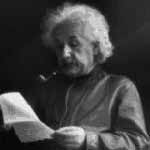 In
the environment of an electrically charged body there is a magnetic field
which furnishes an apparent contribution to its inertia. Should it not
be possible to explain the total inertia of the particles electromagnetically.
In
the environment of an electrically charged body there is a magnetic field
which furnishes an apparent contribution to its inertia. Should it not
be possible to explain the total inertia of the particles electromagnetically.
The Maxwell equations in their original form do not, however, allow such a
description of particles, because their corresponding solutions contain a singularity.
Theoretical physicists have tried for a long time (1936), therefore, to reach
the goal by a modification of Maxwell's equations. These attempts have, however,
not been crowned with success.
Thus it happened that the goal of erecting a pure electromagnetic field theory
of matter remained unattained for the time being, although in principle no
objection could be raised against the possibility of reaching such a goal.
What appears certain to me, however, is that, in the foundations of any consistent
field theory the particle concept must not appear in addition to the field
concept. The whole theory must by based solely on partial differential equations
and their singularity-free solutions. (Albert Einstein)
Richard Feynman avoided this problem with renormalization whereby infinity is subtracted from infinity and the correct experimental result was substituted into the equation.
 Paul
Dirac wrote;
Paul
Dirac wrote;
Sensible mathematics involves neglecting a quantity when it turns out to be small - not neglecting it just because it is infinitely great and you do not want it! (Paul Dirac)
Richard Feynman also knew this;
 But
no matter how clever the word, it is what I call a dippy process! Having
to resort to such hocus pocus has prevented us from proving that the
theory of quantum electrodynamics is mathematically self consistent.
... I suspect that renormalization is not mathematically legitimate.
(Richard Feynman, 1985)
But
no matter how clever the word, it is what I call a dippy process! Having
to resort to such hocus pocus has prevented us from proving that the
theory of quantum electrodynamics is mathematically self consistent.
... I suspect that renormalization is not mathematically legitimate.
(Richard Feynman, 1985)
The solution is to realize that spherical waves in Space (scalar waves described in quantum theory) have a finite wave amplitude at the wave-center and thus eliminate the need for a particle to prevent the radius of the field tending to a singularity with infinite field strength. This then also explains Einstein's last comment that The whole theory must by based solely on partial differential equations and their singularity-free solutions. He just needed to consider the Spherical Standing Wave Structure of Matter rather the continuous spherical field structure of matter!
 The Puzzle of the Photon 'Particle' Theory of Light.
The Puzzle of the Photon 'Particle' Theory of Light.
To begin, let us consider Feynman's argument that light is a particle. (Despite Richard Feynman using spherical electromagnetic waves to explain light, he also paradoxically argued that light must be a particle - thus maintaining the particle/wave duality of light).
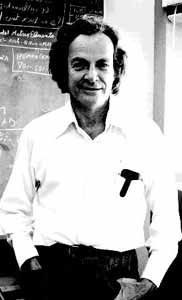 When
experiments were made with very weak light hitting photomultipliers,
the wave theory collapsed: as the light got dimmer and dimmer, the photomultipliers
kept making full sized clicks - there were just fewer of them. Light
behaves as particles. This state of confusion was called the 'wave/particle
duality' of light. (Richard Feynman, 1985)
When
experiments were made with very weak light hitting photomultipliers,
the wave theory collapsed: as the light got dimmer and dimmer, the photomultipliers
kept making full sized clicks - there were just fewer of them. Light
behaves as particles. This state of confusion was called the 'wave/particle
duality' of light. (Richard Feynman, 1985)
For many years after Newton, partial reflection by two surfaces was happily
explained by a theory of waves,* but when experiments were made with very weak
light hitting photomultipliers, the wave theory collapsed: as the light got
dimmer and dimmer, the photomultipliers kept making full sized clicks - there
were just fewer of them. Light behaves as particles.
* This idea made use of the fact that waves can combine or cancel out, and
the calculations based on this model matched the results of Newton's experiments,
as well as those done for hundreds of years afterwards. But when experiments
were developed that were sensitive enough to detect a single photon, the wave
theory predicted that the clicks of a photomultiplier would get softer and
softer, whereas they stayed at full strength - they just occurred less and
less often. No reasonable model could explain this fact.
This state of confusion was called the wave - particle duality of light. (Richard
Feynman, 1985)
The classical wave theory suggested that light could have any wavelength,
because any acceleration of the electron (to produce light) was possible.
It was therefore thought that an electron would eventually absorb enough
energy from these continuous waves of light, such that it would be ejected
from a metal plate. This is not correct, as the photoelectric effect
has demonstrated.
The only solution appeared to be the proposal that light must be a particle
with discrete energy; and mathematical relationships based upon this idea have
proved to be true. But does this prove that light must be a particle? It does
not.
Feynman said NO reasonable model could explain this fact. While this may have
been true in 1985, it is no longer true once we understand the Spherical Standing
Wave Structure of Matter.
As the Wave Structure of Matter explains, it is this false assumption that light must be a 'photon particle', rather than simply being a discrete energy exchange between standing waves, which leads to much of the strangeness and contradiction of modern quantum theory.
 The Puzzle of Antimatter: Positron moving 'backwards
in time'
The Puzzle of Antimatter: Positron moving 'backwards
in time'
The backwards-moving electron when viewed with time moving forwards appears the same as an ordinary electron, except that it is attracted to normal electrons - we say it has a positive charge. For this reason it's called a positron. This phenomena is general. Every particle in Nature has an amplitude to move backwards in time, and therefore has an anti-particle. (Richard Feynman, 1985)
As Wolff explains this is simply a mathematical truth caused by the fact that if you substitute a negative time into the spherical wave equations, then this changes the phase of the standing waves to be equal and opposite, which corresponds to antimatter. Further, notice what Richard Feynman says about photons, which are treated as particles in QED, and thus by Richard Feynman's logic there should also be anti-photons, whereas the WSM is clear on this point - there are anti-electrons (positrons) which are opposite phase Spherical Standing Waves, but there are no separate photon particles, thus no anti-photons!
And what about photons? Photons look exactly the same in all respects when they travel backwards in time, so they are their own anti-particles. You see how clever we are at making an exception part of the rule! (Richard Feynman, 1985)
While it may be clever, it is not good philosophy, and it has led to a very confused and absurd modern physics, and has led to the self fulfilling belief that we can never correctly describe and understand Reality, as Feynman and Heisenberg argued;
The more you see how strangely Nature behaves, the harder it is to make a model that explains how even the simplest phenomena actually work. So theoretical physics has given up on that. (Richard Feynman, 1985)
 Light
and matter are both single entities, and the apparent duality arises in
the limitations of our language.
Light
and matter are both single entities, and the apparent duality arises in
the limitations of our language.
(Werner Heisenberg, 1930)
In fact Nature (Reality) must be logical to explain how we have evolved a logical aspect to our minds that allows us to create mathematical physics which correctly describes so many phenomena.
 The Reflection of Light from a Mirror
The Reflection of Light from a Mirror
Explaining Richard Feynman's 'QED - The Strange Theory of Light and Matter' (1985)
Before reading this explanation it would help if you read the page on
Light.
Very briefly, Light is a wave
phenomena, but Standing Wave Interactions (Resonant Coupling) only
occur at discrete frequencies. The electrons in matter are effectively
bound to the nucleus and form complex (oscillating) standing wave patterns.
Only discrete standing wave patterns are allowed and light is emitted
and absorbed as electrons move from one wave pattern to another. This
explains Schrodinger's wave equations which correspond to the discrete
energy states of Matter and Light Quanta (Photons).
For a mirror, the light waves are not really reflected. Instead, high energy
/ wave state electrons in the light source resonantly couple with the electrons
in the mirror, causing these to move into a higher energy wave state. These
electrons in the mirror then effectively become the light source, and resonantly
couple with electrons in the detector, giving the appearance that light has
gone from the source to the detector by 'reflecting' of the mirror.
Let us now examine Feynman's experiment of light reflecting from a mirror (p-39) to show how a contradictory photon/particle structure of light and matter is sensibly replaced by the Wave Structure of Matter and Light.
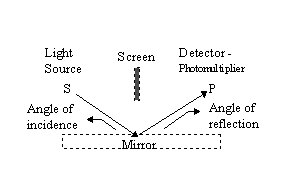
Fig.1 The classical view of the world says that the mirror will reflect light where the angle of incidence is equal to the angle of reflection.
At S we have a source that emits light of one color at
very low intensity. The source emits one photon at a time. At P, we place
a photomultiplier to detect photons.
Now we would expect that all the light that reaches the detector reflects of
the middle of the mirror, because that's the place where the angle of incidence
equals the angle of reflection. And it seems fairly obvious that the parts
of the mirror out near the two ends have as much to do with the reflection
as the price of cheese, right? (Richard Feynman, 1985)
Feynman is correct in saying this, based upon classical wave theory,
which we know is wrong.
But based upon the idea of light as resonant coupling between two spherical
standing waves (electrons) bound in oscillating wave patterns in atoms / molecules,
then we find a sensible explanation to Feynman's strange theory of light and
matter. It becomes obvious that the Spherical Wave Structure of Matter predicts
that the light source will interact with the whole mirror, as Feynman explains.
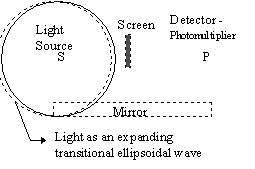
Fig.2 As Light is a Transitional / Oscillating Spherical Standing Wave Interaction, it has an effect on all of the Matter of the Mirror.
Although you might think that the parts of the mirror near the two ends have nothing to do with the reflection of the light that goes from the source to the detector, let us look at what quantum theory has to say. Rule: The probability that a particular event occurs is the square of the final arrow that is found by drawing an arrow for each way the event could happen, and then combining the arrows. (Richard Feynman, 1985)
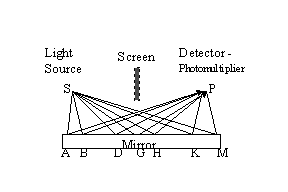
Fig. 3 The quantum view of the world says that light has an equal amplitude to reflect from every part of the mirror, from A to M.
You might think I'm crazy, because for most of the ways I told you a photon could reflect off the mirror, the angles aren't equal. But I'm not crazy, because that's the way light really goes. How can that be? ... (Richard Feynman, 1985)
Feynman is not crazy, he has simply confirmed what the Wave Structure of Matter tells us is true. Spherical Waves do 'take all possible paths' and thus can 'reflect' of any part of the mirror. What is crazy is the idea that a single photon particle can 'reflect / bounce' of all these different places. This does not make sense because it is not true. Light is not a particle it is a spherical standing wave interaction.
So the theory of quantum electrodynamics gave the right answer - the middle of the mirror is the important part for reflection - but this correct result came out at the expense of believing that light reflects all over the mirror, and having to add a bunch of little arrows together whose sole purpose was to cancel out. All that might seem to you to be a waste of time - some silly game for mathematicians only. After all, it doesn't seem like real physics to have something there that only cancels out! (Richard Feynman, 1985)
The Wave Structure of Matter obviously explains how waves cancel out. Light, as resonant coupling between two spherical standing waves (electrons) interacts with all the matter of the mirror. It is only where the angle of incidence equals the angle of reflection that the waves do not cancel each other out. Therefore we see light as traveling on this classical path only.
Feynman tests his theory that the whole mirror can reflect in the following way;
Let's test the idea that there really is reflection going on all over the mirror by doing another experiment. First, let's chop off most of the mirror, and leave about a quarter of it over on the left. (Richard Feynman, 1985)
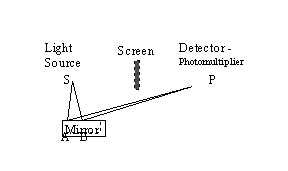
Fig. 4 When light reflects from only part of the mirror, then the waves cancel out, and no light is observed at P.
Feynman then demonstrates that no reflection is observed because the sum of all the paths cancels out. He then cleverly proves this in the following way.
But let's suppose we carefully scrape the mirror away in those areas whose arrows have a bias in one direction. (Which is causing the waves to cancel out.) (Richard Feynman, 1985)
We would expect that if we only allow waves to interact on paths that constructively interfere, and we eliminate paths where waves cancel, that light should now 'reflect' of this segmented mirror (diffraction grating). It does. As Feynman says;
Isn't it wonderful, - you can take a piece of mirror where you didn't expect any reflection, scrape away part of it, and it reflects. (Richard Feynman, 1985)
It is also wonderful that the Wave Structure of Matter sensibly explains this experiment. That resonant coupling between electrons only occurs when their waves interfere in a constructive way (which the diffraction grating allows). Effectively, for spherical standing waves, we must consider the wave interference of all possible paths in space. Feynman agrees.
Demonstrating the reality of reflection from all parts of the mirror shows that there is an amplitude for every way an event can happen. So light doesn't really travel only in a straight line; it smells the neighbouring paths around it. (Richard Feynman, 1985)
Yes, well 'smells the neighbourhood' is one way of saying it, but it leaves science in a bad state of affairs. The Wave Structure of Matter clearly explains the phenomena of light reflecting from a mirror in a way that does not require any of Feynman's strangeness (strange being a uniquely human trait I suspect).
To achieve an exact calculation of how light reflects, we must consider the oscillating spherical wave patterns from the light source to the mirror, and then from the matter of the mirror to the detector. Thus it is necessary to consider the wave interference of all these waves, the net result being that only where the angle of incidence equals the angle of reflection do the waves not cancel out, and thus the electrons / spherical standing waves can resonantly couple with one another. By scraping away some of the electrons from the mirror, we are able to make a mirror / grating which only allows electrons to emit light waves which are in phase and result in constructive interference, such that the mirror / grating is able to reflect light.
 The Double-Slit Experiment
The Double-Slit Experiment
Let us now briefly consider the famous double slit experiments for both photons and electrons. There is a fundamental contradiction in the assumption that a single photon, as a particle, is able to go through both slits simultaneously, and thus produce an interference pattern. Yet experimental observation confirms the existence of an interference pattern. Feynman explains this experiment as such;
... very weak light of one color - one photon at a time - goes from a source at S to a detector at D. (Richard Feynman, 1985)
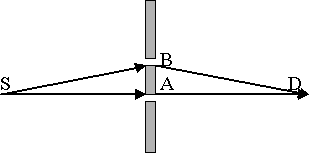
Fig. 5 Two small holes (at A and B) in a screen that is between a source S and a detector D let nearly the same amount of light through (in this case 1%) when one or the other hole is open. When both holes are open, interference occurs; the detector clicks from zero to 4% of the time, depending on the separation of A and B.
Feynman argues;
One would normally think that opening a second hole would always increase the amount of light reaching the detector, but that's not what actually happens. And so saying that light goes either one way or the other is false. I still catch myself saying, Well, it goes either this way or that way, but when I say that, I have to keep in mind that I mean in the sense of adding amplitudes: the photon has an amplitude to go one way, and an amplitude to go the other way. (Richard Feynman, 1985)
As before, quantum theory calculates the correct answer, by considering
both paths as possible, and therefore 'probability interference' occurs.
But this still contradicts the very idea that light is a particle, for
how is it possible for one particle go through both slits and produce
an interference pattern?
The Wave Structure of Matter clearly solves these problems of the interference
of light in the double slit experiment. From memory I think it was Feynman
who said that a credible theory of reality must explain the double slit experiment.
He was correct. So let us have a brief look at this famous experiment by Thomas
Young (in 1801 I think).
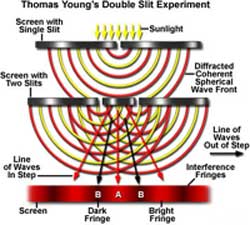
Fig. 6 The interference of light in Young's double slit experiment.
Young's double slit experiment provides a method for measuring the wavelength of light. In fact, Young used this technique to make the first measurement of the wavelength of light. Additionally, the experiment gave the wave model of light a great deal of credibility. It was inconceivable that particles of light coming through the slits could cancel each other in a way that would explain the regions of darkness. (Serway)
Electrons and the Double Slit Experiment
In this experiment we find similar interference results for electrons as observed for light passing through two slits. As with the previous experiment, we also find that if we close either slit, then the interference pattern disappears. The Wave Structure of Matter does sensibly explain this interference of the 'particle' with both slits. This 'particle', being caused by the Wave-Center of a SPherical Standing Wave, does pass through one slit. But we must also consider that the other slit will have some effect on the incoming spherical (ellipsoidal) waves, which determines the future position of the wave-center 'particle'. In the two slit experiment, the effect of the other slit must always be non symmetrical, it effects only the incoming waves on one side of the wave-center, dependant upon which slit the wave-center passes through. It is this interference that logically causes the interference pattern for electrons in this experiment.
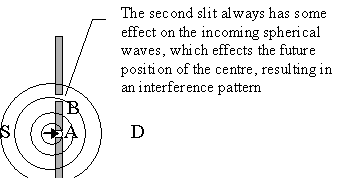
Fig. 7 The Electron in the Two Slit Experiment
This view of things from the foundation of the WSM is consistent with modern physics.
In order to interpret these results, one is forced to conclude that an electron interacts with both slits simultaneously. (Serway)
To end this section on the two slit experiment, I wish, very briefly, to speculate on how resonating space affects the velocity of light. It seems likely that as space is resonating, then the velocity of light varies in a wave function, about an average which is c. This factor must be considered in any experiment, as Feynman argues;
It may surprise you that there is an amplitude for a photon to go at speeds faster or slower than the conventional speed, c. (Richard Feynman, 1985)
As material objects in space are resonating, it is reasonable to conclude that the interference in this experiment is due to the time in the cycle of resonance that the photon or electron is emitted. i.e. As the velocity of light varies in a cyclical nature, due to resonating space, then depending on which relative stage of the cycle that the event occurs in, will give rise to slightly different results. As Feynman says;
In reality, the angle of the amplitude for a given path depends on what time the photon is emitted from the source. (Richard Feynman, 1985)
 Richard Feynman Biography
Richard Feynman Biography
Richard Phillips Feynman (May 11, 1918–February 15, 1988) was one of the most influential American physicists of the 20th century, expanding greatly the theory of quantum electrodynamics. As well as being an inspiring lecturer and amateur musician, he helped in the development of the atomic bomb and was later a member of the panel which investigated the Space Shuttle Challenger disaster. For his work on quantum electrodynamics, Feynman was one of the recipients of the Nobel Prize in Physics for 1965, along with Julian Schwinger and Sin-Itiro Tomonaga.
Richard Feynman was born in Far Rockaway, Queens, New York; his parents were Jewish, although they did not practice Judaism as a religion. The young Feynman was heavily influenced by his father who encouraged him to ask questions in order to challenge orthodox thinking. His mother instilled in him a powerful sense of humor which he kept all his life. As a child, he delighted in repairing radios and had a talent for engineering.
Richard Feynman received a bachelor's degree from the Massachusetts Institute of Technology in 1939 and a Ph.D. from Princeton University in 1942; his thesis advisor was John Archibald Wheeler. After Feynman completed his thesis on quantum mechanics, Wheeler showed it to Albert Einstein, but Einstein was unconvinced.
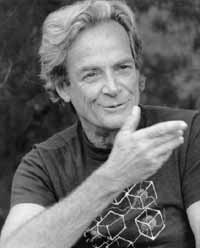 At
Princeton, the physicist Robert R. Wilson encouraged Richard Feynman
to participate in the Manhattan Project—the wartime U.S. Army project
at Los Alamos developing the atomic bomb. He immersed himself in work
on the project, and was present at the Trinity bomb test. Feynman claimed
to be the only person to see the explosion without the dark glasses provided,
looking through a truck windshield to screen out harmful ultraviolet
frequencies. As a junior physicist, his work on the project was relatively
removed from the major action, consisting mostly of administering the
computation group of human computers in the Theoretical division, and
then, with Nicholas Metropolis, setting up the system for using IBM punch
cards for computation.
At
Princeton, the physicist Robert R. Wilson encouraged Richard Feynman
to participate in the Manhattan Project—the wartime U.S. Army project
at Los Alamos developing the atomic bomb. He immersed himself in work
on the project, and was present at the Trinity bomb test. Feynman claimed
to be the only person to see the explosion without the dark glasses provided,
looking through a truck windshield to screen out harmful ultraviolet
frequencies. As a junior physicist, his work on the project was relatively
removed from the major action, consisting mostly of administering the
computation group of human computers in the Theoretical division, and
then, with Nicholas Metropolis, setting up the system for using IBM punch
cards for computation.
After the project, Richard Feynman started working as a professor at Cornell University, where Hans Bethe, who proved that the Sun's source of energy was nuclear fusion, worked. However he felt uninspired there; despairing that he had burned out, he turned to less useful, but fun problems, such as analyzing the physics of a twirling, rotating dish, as it is being balanced by a juggler. As it turned out, this work served him in future researches. He was therefore surprised to be offered professorships from competing universities, eventually choosing to work at the California Institute of Technology at Pasadena, California, despite being offered a position near Princeton, at the Institute for Advanced Study (which included, at that time, such distinguished faculty as Albert Einstein).
Richard Feynman rejected the Institute on the grounds that there were no teaching duties. Feynman found his students to be a source of inspiration and also, during uncreative times, comfort. He felt that if he could not be creative, at least he could teach. Richard Feynman is sometimes called the "Great Explainer"; he took great care when explaining topics to his students, making it a moral point not to make a topic arcane, but accessible to others. He opposed the rote learning and other teaching methods that emphasised form over function everywhere, from a conference on education in Brazil to state commission on school textbook selection. Clear thinking and clear presentation were fundamental prerequisites for his attention.
The Caltech years
Richard Feynman did much of his best work while at Caltech, including research in:
 Quantum
electrodynamics. The problem for which Feynman won his Nobel
Prize involved the probability of quantum states changing. He helped
develop a functional integral formulation of quantum mechanics, in
which every possible path from one state to the next is considered,
the final path being a sum over the possibilities.
Quantum
electrodynamics. The problem for which Feynman won his Nobel
Prize involved the probability of quantum states changing. He helped
develop a functional integral formulation of quantum mechanics, in
which every possible path from one state to the next is considered,
the final path being a sum over the possibilities.
Physics of the superfluidity of supercooled liquid helium, where helium seems
to display a lack of viscosity when flowing. Applying the Schrödinger
equation to the question showed that the superfluid was displaying quantum
mechanical behavior observable on a macroscopic scale. This helped enormously
with the problem of superconductivity.
A model of weak decay, which showed that the current coupling in the process
is a combination of vector and axial. (An example of weak decay is the decay
of a neutron into an electron, a proton, and an anti-neutrino.) Although E.C.
George Sudharsan and Robert Marshak developed the theory nearly simultaneously,
Feynman's collaboration with Murray Gell-Mann was seen as the seminal one,
the theory was of massive importance, and the weak interaction was neatly described.
He also developed Feynman diagrams, a bookkeeping device which helps in conceptualising
and calculating interactions between particles in spacetime. This device allowed
him, and now others, to work with concepts which would have been less approachable
without it, such as time reversibility and other fundamental processes. These
diagrams are now fundamental for string theory and M-theory, and have even
been extended topologically. Feynman's mental picture for these diagrams started
with the hard sphere approximation, and the interactions could be thought of
as collisions at first. It was not until decades later that physicists thought
of analyzing the nodes of the Feynman diagrams more closely. The world-lines
of the diagrams have become tubes to better model the more complicated objects
such as strings and M-branes.
From his diagrams of a small number of particles interacting in spacetime, Feynman could then model all of physics in terms of those particles' spins and the range of coupling of the fundamental forces. The quark model, however, was a rival to Feynman's parton formulation. Feynman did not dispute the quark model; for example, when the 5th quark was discovered, Feynman immediately pointed out to his students that the discovery implied the existence of a 6th quark, which was duly discovered in the decade after his death.
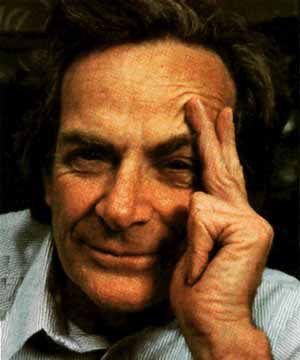 After
the success of quantum electrodynamics, Feynman turned to quantum gravity.
By analogy with the photon, which has spin 1, he investigated the consequences
of a free massless spin 2 field, and was able to derive the Einstein
field equation of general relativity, but little more. Unfortunately,
at this time he became exhausted by working on multiple major projects
at the same time, including his Lectures in Physics.
After
the success of quantum electrodynamics, Feynman turned to quantum gravity.
By analogy with the photon, which has spin 1, he investigated the consequences
of a free massless spin 2 field, and was able to derive the Einstein
field equation of general relativity, but little more. Unfortunately,
at this time he became exhausted by working on multiple major projects
at the same time, including his Lectures in Physics.
While at Caltech, Feynman was asked to "spruce up" the teaching of undergraduates. After three years devoted to the task, a series of lectures was produced, eventually becoming the famous Feynman Lectures on Physics, which are a major reason that Feynman is still regarded by most physicists as one of the greatest teachers of physics ever. Feynman later won the Oersted Medal for teaching, of which he seemed especially proud. His students competed keenly for his attention; once he was awakened when a student solved a problem and dropped it in his mailbox at home; glimpsing the student sneaking across his lawn, he could not go back to sleep, and he read the student's solution. That morning his breakfast was interrupted by another triumphant student, but Feynman informed this student that he was too late.
Feynman was a keen and influential popularizer of physics in both his books and lectures, notably a seminal 1959 talk on nanotechnology called There's Plenty of Room at the Bottom. Feynman offered $1000 prizes for two of his challenges in nanotechnology. He was also one of the first scientists to realise the possibility of quantum computers. Many of his lectures and other miscellaneous talks were turned into books such as The Character of Physical Law and QED: The Strange Theory of Light and Matter. He would give lectures which his students would annotate into books, such as Statistical Mechanics and Lectures on Gravity. The Lectures on Physics took a physicist, Robert B. Leighton, as full-time editor a number of years.
Richard Feynman Biography
https://en.wikipedia.org/wiki/Richard_Feynman
 Richard Feynman Quotes on Science & Knowledge
Richard Feynman Quotes on Science & Knowledge
One does not, by knowing all the physical laws as we know them today, immediately obtain an understanding of anything much. (Richard Feynman on Quantum Theory)
The next question was - what makes planets go around the sun? At the time of Kepler some people answered this problem by saying that there were angels behind them beating their wings and pushing the planets around an orbit. As you will see, the answer is not very far from the truth. The only difference is that the angels sit in a different direction and their wings push inward. (Richard Feynman, Character Of Physical Law)
I love only nature, and I hate mathematicians. (Richard Feynman, on Quantum Theory, 1918-1988)
What I am going to tell you about is what we teach our
physics students in the third or fourth year of graduate school... It
is my task to convince you not to turn away because you don't understand
it. You see my physics students don't understand it. ... That is because
I don't understand it. Nobody does.
(Feynman, Richard P. Nobel Lecture, 1966, 1918-1988, QED,
The Strange Theory of Light and Matter)
Now if the world of nature is made of atoms, and we too
are made of atoms and obey physical laws, the most obvious interpretation
of this evident distinction between past and future, and this irreversibility
of all phenomena, would be that some laws, some of the motion laws of
the atoms, are going one way – that the atom laws are not such
that they can go either way. There should be somewhere in the works some
kind of principle that uxles only make wuxles, and never vice versa,
and so the world is turning away from uxley character to wuxley character
all the time – and this one-way business of the interactions of
things should be the thing that makes the whole phenomena of the world
seem to go one way.
But we have not found this yet. That is, in all the laws of physics that we
have found so far there does not seem to be any distinction between the past
and the future. The moving picture should work the same going both ways, and
the physicist who looks at it should not laugh.
(The Distinction of Past and Future, from The Character of Physical Law, Richard
Feynman, 1965)
No government has the right to decide on the truth of
scientific principles, nor to prescribe in any way the character of the
questions investigated. Neither may a government determine the aesthetic
value of artistic creations, nor limit the forms of literacy or artistic
expression. Nor should it pronounce on the validity of economic, historic,
religious, or philosophical doctrines. Instead it has a duty to its citizens
to maintain the freedom, to let those citizens contribute to the further
adventure and the development of the human race.
(Richard Feynman, The Uncertainty of Values, The Meaning of
it All)
Science alone of all the subjects contains within itself
the lesson of the danger of belief in the infallibility of the greatest
teachers in the preceding generation . . .Learn from science that you
must doubt the experts. As a matter of fact, I can also define science
another way: Science is the belief in the ignorance of experts.
(Richard Feynman, The Pleasure of Finding Things Out (1999)
p. 186-187. This work is based on transcriptions from an interview made in
1981.)
You can know the name of a bird in all the languages of
the world, but when you're finished, you'll know absolutely nothing whatever
about the bird... So let's look at the bird and see what it's doing —that's
what counts. I learned very early the difference between knowing the
name of something and knowing something.
(Richard Feynman, What is Science?, presented at the fifteenth
annual meeting of the National Science Teachers Association, 1966 in New York
City, and printed in The Physics Teacher Vol. 7, issue 6, 1968, pp. 313-320.)
If, in some cataclysm, all scientific knowledge were to
be destroyed, and only one sentence passed on to the next generation
of creatures, what statement would contain the most information in the
fewest words? I believe it is the atomic hypothesis (or atomic fact,
or whatever you wish to call it) that all things are made of atoms -
little particles that move around in perpetual motion, attracting each
other when they are a little distance apart, but repelling upon being
squeezed into one another. In that one sentence you will see an enormous
amount of information about the world, if just a little imagination and
thinking are applied.
(The Feynman Lectures on Physics)
Poets say science takes away from the beauty of the stars— mere globs of gas atoms. Nothing is 'mere'. I too can see the stars on a desert night, and feel them. But do I see less or more? The vastness of the heavens stretches my imagination— stuck on this carousel my little eye can catch one-million-year-old light. A vast pattern— of which I am a part... What is the pattern or the meaning or the why? It does not do harm to the mystery to know a little more about it. For far more marvelous is the truth than any artists of the past imagined it. Why do the poets of the present not speak of it? What men are poets who can speak of Jupiter if he were a man, but if he is an immense spinning sphere of methane and ammonia must be silent. (Footnote in The Feynman Lectures on Physics)
So, ultimately, in order to understand nature it may be
necessary to have a deeper understanding of mathematical relationships.
But the real reason is that the subject is enjoyable, and although we
humans cut nature up in different ways, and we have different courses
in different departments, such compartmentalization is really artificial,
and we should take our intellectual pleasures where we find them.
(The Feynman Lectures on Physics)
For a successful technology, reality must take precedence over public relations, for Nature cannot be fooled. (Richard Feynman, Rogers' Commission Report into the Challenger Crash. Appendix F: Personal Observations on the Reliability of the Shuttle.)
The third aspect of my subject is that of science as a method of finding things out. This method is based on the principle that observation is the judge of whether something is so or not. All other aspects and characteristics of science can be understood directly when we understand that observation is the ultimate and final judge of the truth of an idea. But "prove" used in this way really means "test," in the same way that a hundred-proof alcohol is a test of the alcohol, and for people today the idea really should be translated as, "The exception tests the rule." Or, put another way, "The exception proves that the rule is wrong." That is the principle of science. If there is an exception to any rule, and if it can be proved by observation, that rule is wrong. (Richard Feynman, The Meaning of it All)
In order to interpret these results, one is forced to
conclude that an electron interacts with both slits simultaneously.
(Richard Feynman, 1985)
And what about photons? Photons look exactly the same in all respects when they travel backwards in time, so they are their own anti-particles. You see how clever we are at making an exception part of the rule! (Richard Feynman, 1985)
The more you see how strangely Nature behaves, the harder it is to make a model that explains how even the simplest phenomena actually work. So theoretical physics has given up on that. (Richard Feynman, 1985)
No government has the right to decide on the truth of
scientific principles, nor to prescribe in any way the character of the
questions investigated. Neither may a government determine the aesthetic
value of artistic creations, nor limit the forms of literacy or artistic
expression. Nor should it pronounce on the validity of economic, historic,
religious, or philosophical doctrines. Instead it has a duty to its citizens
to maintain the freedom, to let those citizens contribute to the further
adventure and the development of the human race.
(Richard Feynman, The Uncertainty of Values, The Meaning of
it All)
You can know the name of a bird in all the languages of
the world, but when you're finished, you'll know absolutely nothing whatever
about the bird... So let's look at the bird and see what it's doing —that's
what counts. I learned very early the difference between knowing the
name of something and knowing something.
(Richard Feynman, What is Science?, presented at the fifteenth
annual meeting of the National Science Teachers Association, 1966 in New York
City, and printed in The Physics Teacher Vol. 7, issue 6, 1968, pp. 313-320.)
Poets say science takes away from the beauty of the stars - mere globs of gas atoms. Nothing is 'mere'. I too can see the stars on a desert night, and feel them. But do I see less or more? The vastness of the heavens stretches my imagination— stuck on this carousel my little eye can catch one-million-year-old light. A vast pattern— of which I am a part... What is the pattern or the meaning or the why? It does not do harm to the mystery to know a little more about it. For far more marvelous is the truth than any artists of the past imagined it. Why do the poets of the present not speak of it? What men are poets who can speak of Jupiter if he were a man, but if he is an immense spinning sphere of methane and ammonia must be silent. (Footnote in The Feynman Lectures on Physics)
So, ultimately, in order to understand nature it may be
necessary to have a deeper understanding of mathematical relationships.
But the real reason is that the subject is enjoyable, and although we
humans cut nature up in different ways, and we have different courses
in different departments, such compartmentalization is really artificial,
and we should take our intellectual pleasures where we find them.
(The Feynman Lectures on Physics)
For a successful technology, reality must take precedence over public relations, for Nature cannot be fooled. (Richard Feynman, Rogers' Commission Report into the Challenger Crash. Appendix F: Personal Observations on the Reliability of the Shuttle.)
The third aspect of my subject is that of science as a method of finding things out. This method is based on the principle that observation is the judge of whether something is so or not. All other aspects and characteristics of science can be understood directly when we understand that observation is the ultimate and final judge of the truth of an idea. But 'prove' used in this way really means 'test' in the same way that a hundred-proof alcohol is a test of the alcohol, and for people today the idea really should be translated as, 'The exception tests the rule.' Or, put another way, 'The exception proves that the rule is wrong.' That is the principle of science. If there is an exception to any rule, and if it can be proved by observation, that rule is wrong. (Richard Feynman, The Meaning of it All)
Don't worry about anything... Go out and have a good time. (Richard Feynman)
I can live with doubt and uncertainty and not knowing. I think it is much more interesting to live not knowing than to have answers that might be wrong. (Richard Feynman)
I cannot define the real problem, therefore I suspect there's no real problem, but I'm not sure there's no real problem. (Richard Feynman)
I don't have to know an answer. I don't feel frightened by not knowing things; by being lost in a mysterious universe without any purpose— which is the way it really is, as far as I can tell, possibly. It doesn't frighten me. (Richard Feynman)
Listen, buddy, if I could tell you in a minute what I did, it wouldn't be worth the Nobel Prize. (Richard Feynman)
Mathematics is not real, but it feels real. Where is this place? (Richard Feynman)
Nature uses only the longest threads to weave her patterns, so each small piece of her fabric reveals the organization of the entire tapestry. (Richard Feynman)
On the infrequent occasions when I have been called upon in a formal place to play the bongo drums the introducer never seems to find it necessary to mention that I also do theoretical physics. (Richard Feynman)
People say to me, "Are you looking for the ultimate laws of physics?" No, I'm not... If it turns out there is a simple ultimate law which explains everything, so be it— that would be very nice to discover. If it turns out it's like an onion with millions of layers... then that's the way it is. (Richard Feynman)
Physics is like sex. Sure, it may give some practical results, but that's not why we do it. (Richard Feynman)
Physics is to math what sex is to masturbation. (Richard Feynman)
Religion is a culture of faith; science is a culture of doubt. (Richard Feynman)
Science is a way of trying not to fool yourself. The first principle is that you must not fool yourself, and you are the easiest person to fool. (Richard Feynman)
Shut up and calculate. (Richard Feynman)
The chance is high that the truth lies in the fashionable direction. But, on the off chance that it is in another direction— a direction obvious from an unfashionable view of field theory— who will find it? Only someone who has sacrificed himself by teaching himself quantum electrodynamics from a peculiar and unfashionable point of view; one that he may have to invent for himself. (Richard Feynman)
The wonderful thing about science is that it's alive. (Richard Feynman)
There are 1011 stars in the galaxy. That used to be a huge number. But it's only a hundred billion. It's less than the national deficit! We used to call them astronomical numbers. Now we should call them economical numbers. (Richard Feynman)
What does it mean, to understand? ... I don't know. (Richard Feynman)
What I cannot create, I do not understand. (Richard Feynman)
When you are solving a problem, don't worry. Now, after you have solved the problem, then that's the time to worry. (Richard Feynman, on his blackboard at time of death in 1988)
https://en.wikiquote.org/wiki/Richard_Feynman
All fundamental processes are reversible. (Richard Feynman)
Do not keep saying to yourself, if you can possible avoid it, 'But how can it be like that?' because you will get 'down the drain,' into a blind alley from which nobody has yet escaped. Nobody knows how it can be like that. (Richard Feynman)
If we will only allow that, as we progress, we remain unsure, we will leave opportunities for alternatives. We will not become enthusiastic for the fact, the knowledge, the absolute truth of the day, but remain always uncertain... In order to make progress, one must leave the door to the unknown ajar. (Richard Feynman)
We cannot define anything precisely! If we attempt to, we get into that paralysis of thought that comes to philosophers, who sit opposite each other, one saying to the other, 'You don't know what you are talking about!' The second one says 'What do you mean by know? What do you mean by talking? What do you mean by you?', and so on. (Richard Feynman)
https://www.amasci.com/feynman.html
Help Humanity
"You must be the change you wish to see in the world."
(Mohandas Gandhi)
 "When forced to summarize the general theory of relativity in one sentence:
Time and space and gravitation have no separate existence from matter. ... Physical objects are not in space, but these objects are spatially extended. In this way the concept 'empty space' loses its meaning. ... The particle can only appear as a limited region in space in which
the field strength or the energy density are particularly high. ...
"When forced to summarize the general theory of relativity in one sentence:
Time and space and gravitation have no separate existence from matter. ... Physical objects are not in space, but these objects are spatially extended. In this way the concept 'empty space' loses its meaning. ... The particle can only appear as a limited region in space in which
the field strength or the energy density are particularly high. ...
The free, unhampered exchange of ideas and scientific conclusions is necessary for the sound development of science, as it is in all spheres
of cultural life. ... We must not conceal from ourselves that no improvement in the present depressing situation is possible without
a severe struggle; for the handful of those who are really determined to do something is minute in comparison with the mass of the lukewarm
and the misguided. ...
Humanity is going to need a substantially new way of thinking if it is to survive!" (Albert Einstein)
 We can now deduce the most simple science theory of reality - the wave structure of matter in space. By understanding how we and everything around us are interconnected
in Space we can then deduce solutions to the fundamental problems of human knowledge in physics, philosophy, metaphysics, theology, education, health, evolution and ecology, politics and society.
We can now deduce the most simple science theory of reality - the wave structure of matter in space. By understanding how we and everything around us are interconnected
in Space we can then deduce solutions to the fundamental problems of human knowledge in physics, philosophy, metaphysics, theology, education, health, evolution and ecology, politics and society.
This is the profound new way of thinking that Einstein
realised, that we exist as spatially extended structures of the universe - the discrete and separate body an illusion. This simply confirms the
intuitions of the ancient philosophers and mystics.
Given the current censorship in physics / philosophy of science journals (based on the standard model of particle physics / big bang cosmology) the internet is the best hope for getting new knowledge
known to the world. But that depends on you, the people who care about science and society, realise the importance of truth and reality.
It is Easy to Help!
Just click on the Social Network links at top of page, or copy a nice image or quote you like and share it. We have a wonderful collection of knowledge from the greatest minds in human history, so people will appreciate your contributions. In doing this you will help a new generation of scientists see that there is a simple sensible explanation of physical reality (One Substance, One Law) - the source of truth and wisdom, the only cure for the madness of man! Thanks! Geoff Haselhurst (Updated May, 2025)
A new scientific truth does not triumph by convincing its opponents and making them see the light, but rather because its opponents eventually die, and a new generation grows up that is familiar with it. (Max Planck, 1920)
"All that is necessary for evil to succeed is for good people to do nothing."
(Edmund Burke)
"In a time of universal deceit - telling the truth is a revolutionary act."
(George Orwell)
"Hell is Truth Seen Too Late."
(Thomas Hobbes)
Legal Disclaimer and Privacy Policy












